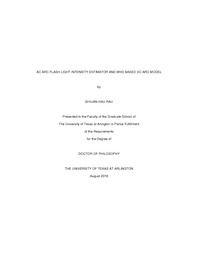
ATTENTION: The works hosted here are being migrated to a new repository that will consolidate resources, improve discoverability, and better show UTA's research impact on the global community. We will update authors as the migration progresses. Please see MavMatrix for more information.
Show simple item record
| dc.contributor.advisor | Lee, Wei-Jen | |
| dc.creator | Rau, Shiuan-Hau | |
| dc.date.accessioned | 2017-09-12T14:55:46Z | |
| dc.date.available | 2017-09-12T14:55:46Z | |
| dc.date.created | 2016-08 | |
| dc.date.issued | 2016-08-10 | |
| dc.date.submitted | August 2016 | |
| dc.identifier.uri | http://hdl.handle.net/10106/26902 | |
| dc.description.abstract | Since the light emitted by arc flash is significantly brighter than the normal lighting background, the light sensors have been applied to the arc flash detection. Currently, the optically based arc flash relaying has been considered as the fastest available protection for arc flash hazard reduction. Although it is well known that high intensity light will be emitted during arc flash event and the human delicate eye structures, such as retina or cornea, can be damaged by the sudden bright light, there are limited research providing the quantitative light intensity estimation during different arcing incidents. This dissertation proposes an arc flash visible light intensity estimation model as perceived by the human eyes based on the measured results from arc flash tests in the high power laboratories. The proposed light intensity estimation model can be used to evaluate the potential impact of an arc flash on the human eyes. In addition, the auto darkening welding lens is used in the arc flash testing to evaluate its effectiveness in attenuating the light intensity and mitigating the light hazard during arc flash event.
DC arc flash hazard assessment is a mounting concern with the growth of applications for large-scale photovoltaic arrays and DC buses. The IEEE Std. 1584-2002 pertains to arc flashes originating in only AC systems. Little research has been conducted to investigate the DC arcs. Currently, there are few methods available to model DC arcs and are largely based on theoretical or semi-empirical methods. The theoretical method, based on the maximum power transfer theorem, overall produces the estimations on the conservative side; the semi-empirical methods are limited by the experiment scale, which cannot provide comprehensive DC arc prediction to the industry. In order to provide a suitable method to predict DC arc flash properties in power systems, new DC arc model development is necessary. This dissertation presents a magnetohydrodynamic (MHD) model of DC arcs. The MHD equations are solved by using computational fluid dynamic (CFD) software Code Saturne®, which is based on collocated finite volume. The simulation results are compatible with the lab testing. The proposed MHD modeling provides an innovative approach to study DC arc phenomena. | |
| dc.format.mimetype | application/pdf | |
| dc.language.iso | en_US | |
| dc.subject | Ambient light sensor | |
| dc.subject | Arc flash | |
| dc.subject | Arc flash hazard | |
| dc.subject | Arc resistance | |
| dc.subject | Arc voltage | |
| dc.subject | DC arc modeling | |
| dc.subject | DC arc simulation | |
| dc.subject | Light hazard | |
| dc.subject | Light measurement | |
| dc.subject | MHD modeling | |
| dc.title | AC ARC FLASH LIGHT INTENSITY ESTIMATOR AND MHD BASED DC ARC MODEL | |
| dc.type | Thesis | |
| dc.degree.department | Electrical Engineering | |
| dc.degree.name | Doctor of Philosophy in Electrical Engineering | |
| dc.date.updated | 2017-09-12T14:55:46Z | |
| thesis.degree.department | Electrical Engineering | |
| thesis.degree.grantor | The University of Texas at Arlington | |
| thesis.degree.level | Doctoral | |
| thesis.degree.name | Doctor of Philosophy in Electrical Engineering | |
| dc.type.material | text | |
Files in this item
- Name:
- RAU-DISSERTATION-2016.pdf
- Size:
- 3.270Mb
- Format:
- PDF
This item appears in the following Collection(s)
Show simple item record


